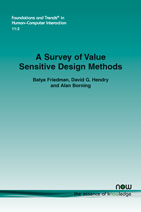A Survey of Value Sensitive Design Methods
By Batya Friedman, University of Washington, USA, batya@uw.edu | David G. Hendry, University of Washington, USA, dhendry@uw.edu | Alan Borning, University of Washington, USA, borning@uw.edu
Abstract
Value sensitive design is a theoretically grounded approach to the design of technology that accounts for human values in a principled and systematic manner throughout the design process. In this article we provide a survey of 14 value sensitive design methods: (1) direct and indirect stakeholder analysis; (2) value source analysis; (3) co-evolution of technology and social structure; (4) value scenario; (5) value sketch; (6) value-oriented semi- structured interview; (7) scalable information dimensions; (8) value-oriented coding manual; (9) value-oriented mockup, prototype, or field deployment; (10) ethnographically informed inquiry regarding values and technology; (11) model of informed consent online; (12) value dams and flows; (13) value sensitive action-reflection model; and (14) Envisioning Cards TM. Each of these methods is honed to the investigation of values in technology, serving such purposes as stakeholder identification and legitimation, value representation and elicitation, and values analysis. While presented individually, the methods are intended to be integrated in a robust value sensitive design process. The survey article begins with a brief summary of value sensitive design methodology and theoretical constructs. We next provide an overview of the 14 methods. Then, we turn to a broader discussion of value sensitive design practice, focussing on some methodological strategies and heuristics to support skillful value sensitive design practice. Following the broad discussion of practice, we illustrate one method in action—value scenarios—providing details on its range of purposes and contexts. We conclude with reflections on core characteristics of value sensitive design methodology, and heuristics for innovation.
A Survey of Value Sensitive Design Methods
Value sensitive design is a theoretically grounded approach to the design of technology that accounts for human values in a principled and systematic manner throughout the design process.
A Survey of Value Sensitive Design Methods looks at 14 value sensitive design methods, each of which is honed to the investigation of values in technology, serving such purposes as stakeholder identification and legitimation, value representation and elicitation, and values analysis. While presented individually, the methods are intended to be integrated in a robust value sensitive design process.
A Survey of Value Sensitive Design Methods begins with a summary of value sensitive design methodology and theoretical constructs. Having introduced the 14 methods, it turns to a broader discussion of value sensitive design practice, focusing on some methodological strategies and heuristics to support skillful value sensitive design practice. Following the broad discussion of practice, it illustrates one method in action—value scenarios—providing details on its range of purposes and contexts. It concludes with reflections on core characteristics of value sensitive design methods, and heuristics for methodological innovation.
